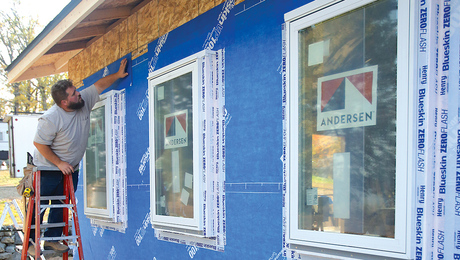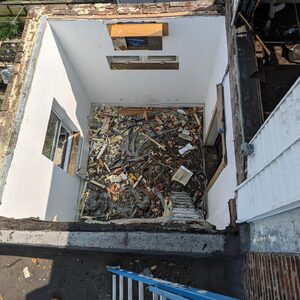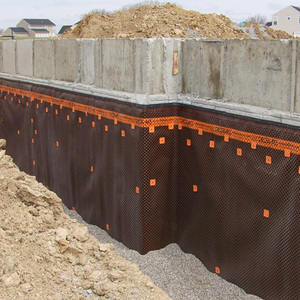Hello,
I know that no one on this forum would give bad or possibly dangerous advice, but I am looking for opinions, etc. on the following scenario:
I am redoing my house, room by room, and presently, am working on the spare bedroom next to the bathroom. I have already mucked around with the toilet drain, when I worked on the basement, and changed it over from cast to ABS. Presently, the toilet drain drops below the floor into a 3″ tee, and runs about 14′ horizontaly, dropping about 5″. The drain then runs into a new vertical vent stack that I installed. The back of the tee is tied into the old vent for the bathroom. I will be eliminating the old vent in the future, when I move the toilet closer to the vertical vent stack.
Long story short, if I cut off and sealed the old vent, how well would the toilet drain, using the new vent. This would only be temporary, ie a couple of months, using this scenario. A sink and tub are also on the 14′ drain line. I don’t think that the velocity of water from the toilet flushing would be fast enough to siphon the trap for the sink or tub, but I could be wrong. I am also aware of all the dangers/problems with sewer gas (I work in a pulp mill where I get to smell hydrogen sulphide on a daily basis, yay!)
I am also thinking about climing up on the roof, plugging the drain, and seeing what happens.
The whole reason for removing the old vent, is so I can lay down a bottom plate, and top plate, without having to cut holes in either.
Any comments?
Sorry about the long winded wording…
Thanks,
Greg



















Replies
I like your idea of plugging the old one and checking but I really think you are worrying about nothing, since it is only temporary. If you see or hear traps sucking, then you know you have a problem.
You could also use an air admittance valve. I cut my main stack off when I tore off my roof (last August) and I've had a large air admittance valve (Studor Maxivent) on since then with just an occasional problem. Sometimes the wash machine draining (in the basement) pushes air back up through the toilets. About once every couple of months. No big deal to me.
MERC.
What exactly would cause air to be pushed up thru the toilet when the washer is dumping? I've got a similar problem, figured that the toilet vent was partially plugged.
My washer drains about 8' where it hits the main stack for the house (tying in about 2' above the basement floor). The air admittance valve it about 15' directly above that point (straight up the stack). There is no seperate vent on the wash machine, I rely on the soil stack.
I assume the washer is filling the soil stack with water and when it pushes water back up the soil stack slighty, it forces air out the toilet because the stack is capped with something that won't let air out.
So I'd agree with you that your vent isn't free flowing for some reason.
MERC.
If your drain line can't take the output of a washing machine you have other problems. Is it a septic system or city sewer? You could have a saturated (or low capacity) drainfield or an obstructed pipe. You should not be backing up into a stack like that.
Yeah, I contemplated that too. A future project will be tear up the basement floor (which was poured by idiots) and redo it. At that time, I'll get a good crack at the soil stack and see what's going on.
It's 40 years old, city sewer. Works for now, so it's not coming to the top of the list.
MERC.
Why don't you get a good plumber in there and grind it out? Or rent one. It might just be tree roots or something easy like that.
At another phase in this remodel, I got access to a 1 1/2" steel pipe that was run under another part of the slab. It was my kitchen sink drain. It had an opening about the size of my thumb AT BEST. I cut off about 10' of that pipe and replumbed the kitchen sink, but it's still dumping into that nearly plugged up steel pipe, just farther down the line. But hopfully that will be coming apart in the next few months when I move the kitchen. At that time I'd guess the CI stack is probably coming apart so it will be convenient to grind it out then.
MERC.
It's really not unusual for a washer to cause a small backup such as described. It's mostly the fact that it takes awhile to get the momentum going in the drain line, and a brief backup occurs until things get flowing.This is exacerbated by any minor clogging (which is common on a washer drain line). Augering the drain line will frequently help things, at least for a few months.
Since this is only temporary, you could live with some minor problems created by not having the toilet properly vented.
That said, the UBC reguires fixture to be vented within 3 feet of the trap. A vent pipe must start up in that distance. A toilet is internaly trapped and should meet this requirement, along with the vent being the same size as the waste line or larger.
It doesn't sound as if you are going to have this inspected, so I would recomend you buy the Code Check Plumbing from Taunton Press. It will give you the basic requirements to plan your future work.
Dave
No problem doing this yourself and saving bucks, but keep in mind venting is important and needs to be done properly for safety reasons. At the very least consult with a licensed plumber and ask if he will evauluate your work and ideas about venting. What ever he charges for a 30 min visit will be well worth it. Ask him a dozen questions, pick his brain and rest assured you will be doing things right. "One measurement is worth a thousand expert opinions"
Thank you for all the responses! I am in a small Northern Ontario town, where everybody is a plumbing "expert"! I figured I'd be doing better by asking questions on this forum.
Anyway, that being said, I beleive that I will use an air admittance valve, and when I do the final work, all venting will be done correctly and up to code (even though it probably won't be inspected).
Thanks,
Greg
Trap arm length varies with diameter, it's not always three feet... I could get outta my chair and go see what it is for 3"... maybe 6 feet?
How big is the pipe on that 14' horizontal run? The diameter will have a big impact on your 'wet venting' potential. For example, my bathroom use to have an 8ft horizontal run to vent with 4in ci pipe, and it worked well like that for 80 years.
I'm also running a temporary waste pipe rerouting with an air admittance valve in my house at this time. I was skeptical about these devices, but it works very well.
Edited 3/4/2005 2:02 pm ET by csnow
The pipe is 3", not quite as large as a 4". I always thought that it was more to do if the pipe dropped more than it's diameter, over the horizontal run.Anyway, I capped off the old vent today, and seems to be working fine. I can let everyone know after supper how it's really working...Just kidding!Greg